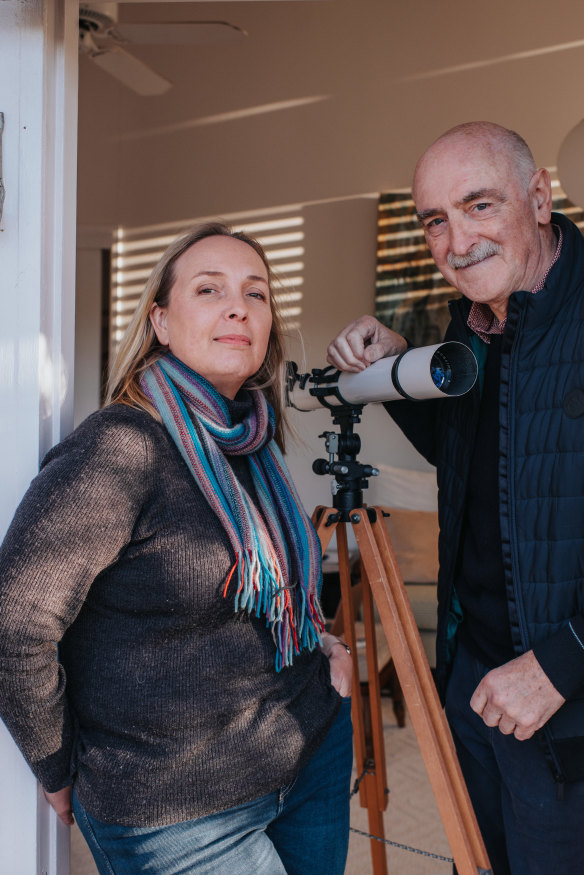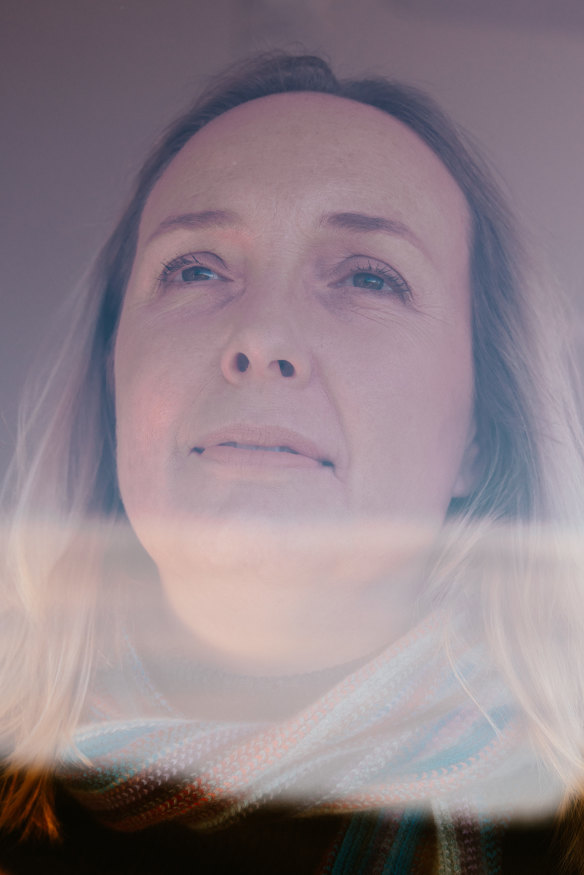This was published 1 year ago
Turn it off! The fight to darken our night skies
Can you see only a handful of heavenly bodies at night? Chances are you live in or near a city – and are one of the eight in 10 people on the planet affected by light pollution.
By Tim Elliott
Marnie Ogg likes to be kept in the dark, especially when it comes to her work. Ogg, 52, is the founder of the Dark Sky Alliance, a charity dedicated to combating light pollution, and the director of an astro-tourism company, Dark Sky Traveller, which takes tour groups to look at, say, a solar eclipse in the Kimberley or the aurora borealis in the Arctic. She is, by nature, a nocturnal creature, a night-sky connoisseur who tolerates daylight as you would a traffic jam, a distraction from life as she prefers it to be; namely, coddled in blackness and lit only by the cosmos. She is, in other words, a bit like a bat or an owl, except that she has blonde hair and is standing beside me dressed in a pair of jeans and a pink fleece vest.
It’s 6.30pm on a winter’s night and we’re on Ogg’s patio in Sydney with her husband, the astronomer Fred Watson. Beside us is a one-metre-long Unitron telescope with which Ogg and Watson are showing me constellations mostly invisible to the naked eye. There’s the Jewel Box (distance from Earth: 6419 light years), a cluster called the Southern Pleiades, and a busy little spray of stars called NGC 2516. To the north looms the moon, which through the telescope looks scabrous and pocked and ominously tranquil. Ogg’s home, which is opposite a national park and sheltered by a ridge from the glow of the city, is well-situated for such stargazing. “It’s actually one of the reasons we bought it in the first place,” she says.
Ogg, who grew up in Avalon on Sydney’s northern beaches, began her career as a flight attendant, before becoming a hotel manager and tour guide. In 2006, she invited Watson, who was a well-known astronomer and media commentator, to host a solar eclipse tour to Cairns. The trip went well, and she moved increasingly into astro-tourism with him. (The pair started dating four years later, and were married in 2019, at the Haleakalã Observatory, in Hawaii.)
Ogg and Watson took tours to observatories in Paris and Stockholm, and went stargazing in the Namib Desert and the Chaco Canyon, in the US. Then, in 2012, they visited Asiago, near Venice, which hosts Italy’s National Telescope. “We were so excited, but it turned out to be disappointing,” she says. “It was completely light polluted. We ended up seeing about 12 stars.”
On her return to Sydney, she walked into her backyard to feed her chickens and was astonished by how dark it was, and how clearly the stars blazed above her. “It was a hundred times better than Italy,” she says. “Light pollution is now increasing by 10 per cent a year, which is scary.” And so, she threw herself into a little-known corner of the environmental movement: dark sky conservation.

Dark Sky Alliance founder Marnie Ogg with her husband, astronomer Fred Watson, at home on Sydney’s northern beaches. “Modern technology has divorced us from the natural world,” she says.Credit: James Brickwood
For 3.7 billion years, life on Earth has evolved according to a regular day/night cycle, a binary rhythm that has shaped everything from our eating and sleeping to our mating habits and migratory patterns. Then, in 1880, Thomas Edison invented the first mass-produced light bulb. Electric light signalled a Promethean leap in human history, allowing us to turn night into day, fuelling huge boosts in productivity and the growth of cities. But as electric light became more available, humans became profligate with its use. By the 1960s, astronomers were using the term “light pollution” to describe the ambient glow caused by city lights at night, an orangey grey pall that made it more difficult to see the stars. Increased development compounded the problem: wherever humans went, light followed – giant lamps on motorways and playing fields; skyscrapers sparkling like Christmas trees; cars and factories and thousands upon thousands of satellites, whizzing through orbit like supersonic baubles, bouncing sunlight down from space.
“We now use light in the same way we used water in the 1970s,” Ogg says. “Spraying it on the driveway and leaving the sprinklers on.”
The idea of a truly dark sky – a sky as our ancestors saw it – is now extinct in many parts of the world. According to a 2016 study published in the journal Science Advances, the Milky Way is now hidden from one-third of humanity. Some 80 per cent of the world’s population lives under light-polluted skies; in the US and Europe, it’s 99 per cent. “A lot of people don’t know what a proper night sky looks like,” says Associate Professor Chris Lidman, the Director of the Siding Spring Observatory near Coonabarabran, in north-western NSW. “You could be in the Swiss Alps, away from anywhere, and think you’re seeing a dark sky, but you’re not.”
The implications of this are both material and ontological. Astronomical research – the kind done by Lidman – seeks to answer some of humanity’s biggest questions, including how time began and are we alone in the universe. As the stars disappear from view, so do the potential answers. Light pollution also impacts animals. On Queensland’s Sunshine Coast, turtle hatchlings, which emerge from their nest at night, are being drawn off course by house lights, away from the ocean and into residents’ backyards, where they are eaten by domestic pets. Insects swarm around night lights until they die from exhaustion. Dung beetles, who navigate by the stars, wander in circles. Clownfish eggs, which only hatch at night, remain dormant. Magpies, kept up at night, lack the energy during the day to forage for food.
It’s tempting to regard light pollution, sometimes called ALAN (artificial light at night), as benign, especially compared with coal-fired power plants or ocean plastics. “People associate light with wellbeing and progress,” says Ogg. But ALAN’s inexorable sprawl has inverted that, birthing a billion-watt, energy-sapping, klieg light-dystopia where birds slam into illuminated skyscrapers, and trees bud weeks early; where there is no corner of our lives that remains hidden, safe from the diode glow of your laptop or a streetlight through the curtain. Not surprisingly, ALAN is making us sick. It suppresses melatonin, the hormone that tells us when to sleep, leading to insomnia. It’s linked to depression, by altering neurotransmitters, like serotonin, that determine mood. A recent study found that ALAN is associated with impaired blood glucose control, with more than nine million cases of ALAN-induced diabetes in China alone.
“Most people, once the sun goes down, they move inside, turn on the lights and switch on the TV. That’s our version of the night, which is kind of sad.”
Marnie Ogg
There are also questions of identity. What would it mean for Australians if the Southern Cross disappeared? (Already, Ginan, the constellation’s fifth and faintest star, can be hard to spot.) For millennia, First Nations peoples used the stars to navigate, forecast the weather and find food. The best example of this in Australia is the “dark emu”, an emu-shaped constellation made by the dust lanes in the Milky Way. The emu’s position in the sky during the year could be used to predict the bird’s behaviour, including when it lays eggs. Light pollution is erasing the emu, along with other significant constellations, a process Duane Hamacher, Associate Professor of Cultural Astronomy at the University of Melbourne, has likened to cultural genocide. Light pollution is “slow violence”, Hamacher wrote in the Journal of Dark Sky Studies, a “whitewashing of the night sky through colonial policy and practice”.
But there is something more elemental at stake. Who hasn’t lay down on the ground and beheld the night sky, “the infinite meadows of heaven”, as poet Henry Wadsworth Longfellow put it, and pondered the mystery of existence? The stars are a link to the mystic, the loss of which impoverishes our deeper being.
“Modern technology has divorced us from the natural world,” Ogg says. “Most people, once the sun goes down, they move inside, turn on the lights and switch on the TV. That’s our version of the night, which is kind of sad.”

“We now use light in the same way we used water in the 1970s,” Ogg says. “Spraying it on the driveway and leaving the sprinklers on.” Credit: James Brickwood
The answer to light pollution is simple – you just turn off the lights. Reducing the number of external lights around your house is a good start; you can also change from harsh LED bulbs to warmer, amber shades. On Queensland’s Sunshine Coast, where many of Australia’s most important loggerhead turtle hatcheries are located, the council has lowered and mounted shields on street lights, and put motion-activated lights in public toilets. “Everyone is on board,” says Kate Hofmeister, conservation officer at Sunshine Coast Council. “We’ve even heard that the police politely remind people to turn off their headlights when they park near the beach.”
Several groups, including Ogg’s Dark Sky Alliance, which she founded in 2019, and the US-based International Dark-Sky Association (IDSA), raise awareness by campaigning for dark sky conservation. In 2019, the IDSA designated a 3000 square-kilometre area near Cambrai, in South Australia, as Australia’s first Dark Sky Reserve. Ogg, who consulted on the project, says the reserve is now marketed at travellers from Asia, where locals often can’t see any stars at all. “More and more governments are becoming aware of the issue, and coming up with protocols to address it,” she says.
Living in Sydney can be exasperating for Ogg. Vivid, Sydney’s annual festival of light, can set her teeth on edge. “We’re not killjoys,” she tells me. “But what scares me is how Vivid gets bigger every year.”
The dark is a spectacle, too. “The best experiences can be when you bring people for the first time to the night sky. Once I had this elderly woman on one of our trips who looked down a telescope and saw Saturn for the first time. She stood back and had tears in her eyes, and she said, ‘I can’t believe this is the first time in my life I have seen this. Why has it taken so long?’ ”
To read more from Good Weekend magazine, visit our page at The Sydney Morning Herald, The Age and Brisbane Times.